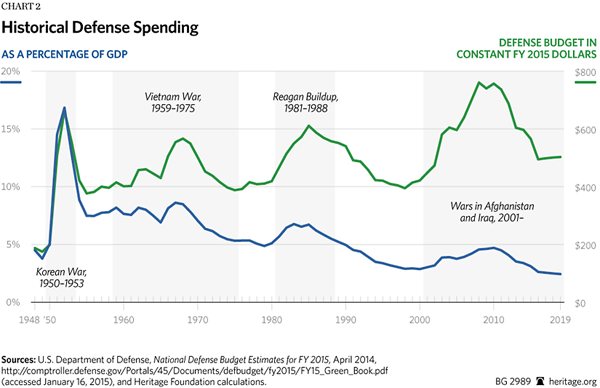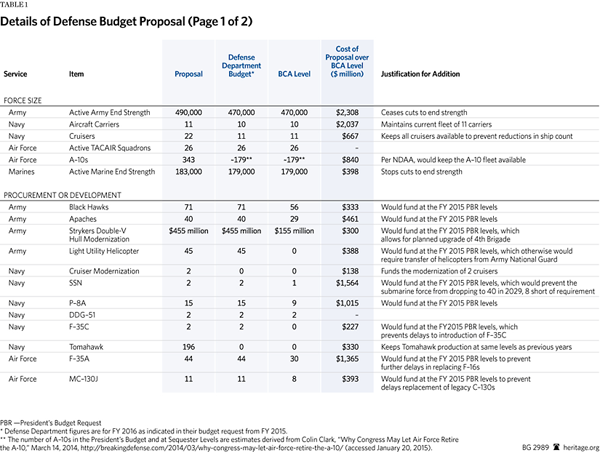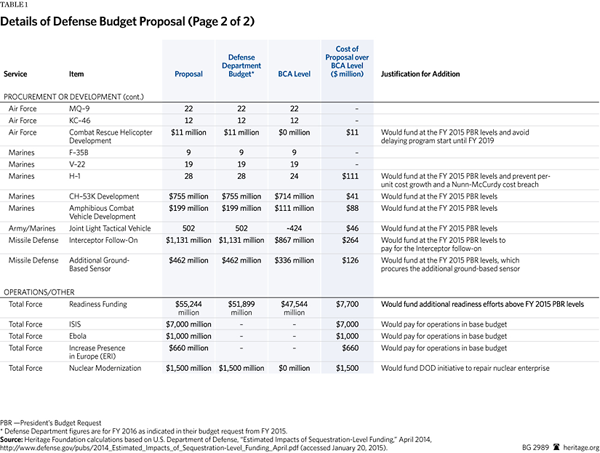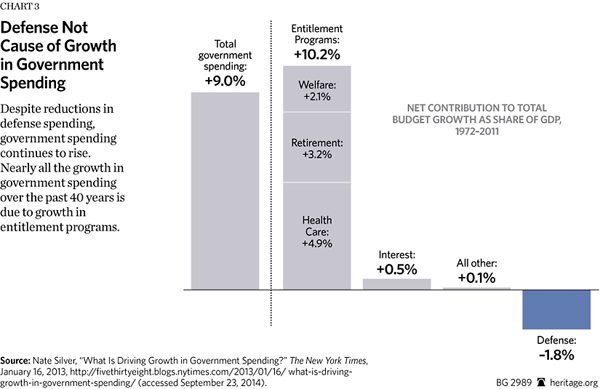U.S. foreign and defense policy has reached a critical juncture. In an astonishingly brief period of time, the world—and America’s place in it—has changed dramatically. During this period, presidential elections, the financial crisis, and government shutdown politics largely supplanted overseas engagements and foreign affairs in the minds of the White House and Congress. The swearing-in of a new Congress and a new majority party in the Senate provides an important opportunity to reassess the objectives of U.S. foreign policy and to align other policy priorities accordingly. The U.S. defense budget is the first among the items to reconsider in the context of a changing international landscape. While foreign policy matters cannot simply be solved with more money for defense, little can be expected to change without it.
Consecutive years of across-the-board budget cuts have significantly weakened the U.S. military. The military will likely need several years of reinvestment to return to a sound footing, and a higher defense budget for fiscal year (FY) 2016 would be an encouraging start.
To that end, for FY 2016, Congress should increase the discretionary caps on defense instituted by the Budget Control Act of 2011 (BCA). Specifically, Congress should allocate $584 billion to defense spending for FY 2016. At the same time, Congress should put America on a path to fiscal responsibility and safeguard national security by reducing deficits and the national debt. Congress’s repeated failures to address out-of-control entitlement spending, the real driver of unsustainable federal spending, means that the BCA’s spending cuts will be short-lived, hampering necessary growth in defense spending. Instead of the status quo, Congress should reform entitlement spending, reduce non-defense discretionary spending, and prioritize its core constitutional function to provide for the common defense.
The Case for Increasing Defense Spending
Two factors justify increasing defense spending:
First, the security situation in many parts of the world has shifted in directions unfavorable to U.S. interests. In the past few years, the constellation of threats to the U.S. has changed, and the U.S. needs to reexamine current defense spending levels, which were set in 2011.
Second, the state of the U.S. military continues to degrade due to recent spending decisions. The several years of uncertainty in the defense budget, the unprioritized cuts, and the magnitude and pace of the reductions have led to a weaker and smaller force today.
The World as It Was. In 2008, then-Senator Barack Obama (D–IL) campaigned on ending the war in Iraq among other issues, and a slight majority of Americans agreed.[1] For better or for worse, the prevailing sentiment was that it was time to end unnecessary military engagements abroad and refocus on domestic issues—on “nation-building here at home.”[2]
In 2009, President Obama began his first term in the White House, and the Democratic Party controlled both the Senate and the House of Representatives. That same year, in line with his campaign promise, President Obama announced plans to withdraw all U.S. troops from Iraq.[3] A decision to reduce the number of troops in Afghanistan would follow in 2011.[4]
President Obama also announced his Russian “reset” policy, based on the notion that the Cold War was over and the U.S. needed to start warming relations with Russia.[5] As part of the reset policy, the U.S. reduced the number of troops based in Europe. Considerations for reduction in defense spending began at the same time.
A Period of Disruption and Upheaval. Reality soon intruded on President Obama’s desire to focus solely on domestic concerns, beginning with Tunisia in December 2010. The Arab Spring protest movement, which affected every country in the Middle East and North Africa to varying degrees, ousted several regional leaders from power and upended the existing geopolitical dynamics in the Middle East. Instability and unrest persist in many of these countries—including Libya, Egypt, and Yemen—with little promise of resolution or stability anywhere on the horizon.
Fragile as those countries are, the legacy of the Arab Spring is nowhere more painfully evident than in border areas of Iraq and Syria. The March 2011 uprising against Bashar al-Assad, Assad’s violent response, and the increasing sectarian strife in Iraq after the withdrawal of American troops would have been unwelcome developments on their own merits, but the turmoil in Iraq and the burgeoning civil war in Syria also paved the way for the emergence of the Islamist terrorist organization known as the Islamic State (ISIS).
ISIS has plunged the region back into widespread armed conflict and turmoil, affecting millions of lives. Large areas of Syria and Iraq are now under ISIS control, while Turkey, Lebanon, and Jordan are facing a refugee crisis. As the President stated, “if left unchecked, these terrorists could pose a growing threat beyond that region, including to the United States.”[6]
In Russia, Vladimir Putin’s invasion and annexation of the Crimean peninsula in April 2014 proved that the talk of a “reset” of relations with Russia was an entirely one-sided narrative. The continuing conflict in eastern Ukraine has cost thousands of Ukrainian lives, and no end is in sight. The stability and relative regional security that European countries had enjoyed since the implosion of the Soviet Union is now very much in doubt.
Other pressing issues include the Ebola epidemic in West Africa; the growing strength of terrorist groups affiliated with al-Qaeda and ISIS, in failed states and ungoverned spaces around the globe, particularly in Africa; China’s increasing displays of aggressiveness; cyberwarfare; and the persistent threat of a nuclear Iran.
Not all of these situations require military intervention, but they do require an acknowledgement that the existing world order bears little resemblance to the one at the beginning of the Obama Administration. In many ways, as noted by the Chairman of the Joint Chiefs of Staff, General Martin E. Dempsey, the world has become more dangerous, and the United States needs to reevaluate its military posture based on a clear-eyed assessment of current threats.[7]
Response and Responsibilities. While there is a significant debate about how to respond to these developments, most in Washington recognize these situations for what they are—threats to U.S. interests—and have once again turned to the military for solutions, placing new demands on an already stressed force. To counter Russia, the U.S. is returning some of the previously withdrawn troops to Europe. More than 3,000 troops are in Iraq, and U.S. and coalition forces have conducted more than 1,000 airstrikes to fight ISIS in Iraq and Syria.[8] The troop presence in Afghanistan, while absent from the headlines in recent years, continues. In Liberia, 2,300 troops are helping to contain the Ebola epidemic.[9]
It is difficult, however, to reconcile policymakers’ inclination to employ the military as a bulwark against all manner of threats with their inaction on the crippling spending cuts of the past several years. The defense budget can only impact the state of the military, not when policymakers call upon it for the next mission. As demonstrated in recent years, cutting the military budget does not necessarily mean the military will do less.
Matching resources to missions for the Department of Defense (DOD) is further complicated by the unique military “can-do” ethos. In other words, even if the military is not fully prepared for a particular mission, they will still undertake that mission if ordered by the President.
When the military is called upon to act, but constrained in its means, it runs greater risks in the endeavor. In conflict, greater risk can mean higher casualty rates or outright failure to complete the mission. If the military is ordered to war without a proper consideration of resources, that risk will be absorbed by the men and women in uniform.
Budgets and the state of the military do not dictate operational tempo. Those are dictated by external factors and by the Commander in Chief and Congress. Given their reliance on the military, it is incumbent on these stakeholders to reverse the spending cuts that increase the risks to the military and threaten its ability to execute.
What Defense Cuts Have Wrought
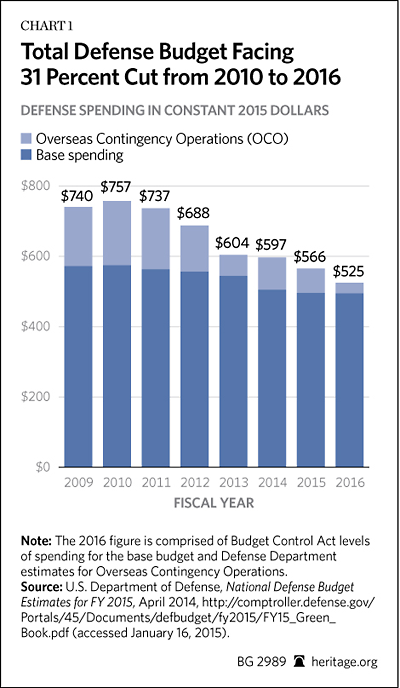
Defense cuts have occurred in three phases over six years. The first phase (FY 2010–FY 2011) incurred a $20 billion reduction in the topline and concentrated cuts on terminating or reducing modernization programs. The FY 2012 budget was then cut by another $49 billion. Unlike previous years, the cuts were focused on reducing end strength and finding internal savings, rather than axing modernization programs. Halfway through FY 2013, the BCA and the Bipartisan Budget Act of 2013 (BBA) dictated the defense budget, cutting another $38 billion to date.
In total, since FY 2010, the defense budget, including overseas contingency operations (OCO) spending, has been cut 25 percent in inflation-adjusted dollars.[10]
FY 2010 and FY 2011. While the FY 2010 budget slightly increased the defense budget, the department began cancelling major programs that year. For the FY 2010 budget, the department announced:
- Cancellation of the F-22 Raptor fighter aircraft;
- Cancellation of the VH-71 presidential helicopter;
- Cancellation of the vehicle portion of the Future Combat System;
- Cancellation of missile defense programs, including the Airborne Laser and the Multi-Kill Vehicle;
- Cancellation of the CSAR-X search and rescue helicopter; and
- The end of C-17 Globemaster III military transport production at 205 aircraft.[11]
In FY 2011, the cuts focused on modernization spending:
- Ending C-17 production at 223. (Congress blocked the first attempt.)
- Cancelling the F-35 alternate engine program.
- Cancelling the CG(X) future large cruiser.
- Cancelling the Navy’s EP-X future intelligence aircraft.[12]
In some cases, these cuts were necessary because the program requirements were not a high priority or because the program was too costly. On the other hand, other cancellations have led to serious problems for the military today. For example, cancellation of the next-generation cruiser will lead to a future shortfall in large surface combatants for the Navy. The Navy is trying to limit the severity of the future shortfall by laying up half of the existing cruisers, thereby extending the life of half of the ships. Meanwhile, the termination of the F-22 program, which was deemed too costly, has left the Air Force with 26-year-old F-15s and no replacement plans. The Air Force’s ability to conduct air superiority missions is now at risk.
FY 2012. The FY 2012 budget request cut $78 billion from the previous year’s Future Years Defense Program (FYDP) for FY 2012–FY 2016.[13] Secretary Robert Gates proposed $178 billion in savings, of which $100 billion would be reinvested into the budget. The savings came from:
- Reducing the Army and Marine Corps end strengths;
- Freezing civilian workforce levels and pay;
- Closing the Joint Forces Command;
- Reducing reports, studies, boards, and commissions;
- Reorganizing staff in each service;
- Improving business practices; and
- Cancelling or reducing additional programs, including the Marine Corps’s Expeditionary Fighting Vehicle (EFV) and the Surface-Launched Advanced Medium-Range Air-to-Air Missile (SLAMRAAM).[14]
FY 2013. The FY 2013 budget request under Secretary Leon Panetta continued the military drawdown. The FY 2013 request was $30 billion lower than the FY 2012 budget, and $259 billion was cut from the FYDP. As in previous years, the military found “savings” of $61 billion, which was cut from the budget rather than reinvested. Examples of such savings were limiting civilian pay raises to 0.5 percent and delaying facility construction projects.[15] In the end, however, the proposed FY 2013 budget was irrelevant. In March 2013, sequestration took effect, negating Secretary Panetta’s drawdown plan.
The 2013 sequestration cut $37.2 billion (6 percent) from the FY 2013 budget.[16] The sequestration was applied by automatically cutting all programs with the exception of military personnel spending. The implementation resulted in an 8.9 percent cut to procurement, an 8.7 percent cut to research and development, and a 7.4 percent cut to operation and maintenance. These were cuts in military readiness from which the DOD is still trying to recover today.
FY 2014 and FY 2015. The BBA provided limited relief from the BCA’s discretionary top lines for FY 2014 and FY 2015, but the defense budget was still far lower than previous plans. Once again, the department made cuts. Most recently, the FY 2015 budget proposed:
- Reducing the Army end strength to 420,000 and Marine Corps end strength to 175,000;
- Retiring one aircraft carrier early, reducing the carrier force to 10;
- Laying up 11 of the 22 cruisers;
- Retiring aircraft, such as the A-10 Thunderbolt II close air support aircraft; and
- Reducing purchases for many modernization programs.
In sum, the past six years of defense cuts have severely degraded the military. It is now smaller, less capable, and ill-prepared for future requirements. Meanwhile, the world has become more tumultuous, increasing the demands on the military.
Supporters of Defense Cuts Are Misguided. Some argue that the spending reductions were not a problem because of the sheer size of the budget and excessive waste in the department. This is a misperception of the DOD budget. While waste does affect the DOD budget, it comprises a small portion of the overall budget, not nearly equivalent to the amount that was cut. To illustrate this, in the “Department of Everything” former Senator Tom Coburn (R–OK) itemizes an expansive list of wasteful programs in the DOD amounting to $67.9 billion over 10 years.[17] If Congress could eliminate every single one of the listed programs, the annual savings would amount to a little more than 1 percent of the budget.
It is also wrong to assume that simply reducing overall defense spending can eliminate waste. In truth, eliminating wasteful spending at the DOD (as in other government institutions) requires separate legislation and internal reform. The past several years of defense spending reduction not only cut the fat, but also much of the actual meat—real U.S. military capabilities.
Another argument in favor of recent defense cuts claims that the department has benefitted from earlier budget growth and that these cuts are just a natural drawdown. As Table 1 shows, defense spending is historically cyclical. Increases in spending tend to be linked to periods of war or conflict and are immediately followed by reductions, as in the past decade, when spending grew after the September 11, 2001, terrorist attacks and the start of the Global War on Terrorism.
However, the post-2001 budget growth cannot be used to justify recent cuts. First, the initial growth was largely invested in capabilities needed specifically to fight Operation Iraqi Freedom and Operation Enduring Freedom, namely end strength and equipment for the Army, such as mine-resistant ambush-protected (MRAP) vehicles and HMMWVs (Humvees).[18] These investments do not necessarily translate into capabilities that may be needed for future military engagements. Second, the defense spending reductions began while military troops were still engaged in hostilities.
Defense in fy 2016 and Beyond
If policymakers choose the status quo, the defense budget for FY 2016 will once again be reduced to the BCA levels of $523 billion. Returning to this level of funding would be detrimental for the military and U.S. national security. The department would have no choice but to make even more severe cuts to end strength and readiness and again delay high-priority programs. At this level of funding, the military would become hollow.[19]
Under BCA funding levels, cuts would include:
- Reducing the Army to 420,000 and the Marines to 175,000;[20]
- Cutting the 11th carrier;[21]
- Reducing Black Hawk helicopter buys by 61 (15 percent of the five-year plan);
- Reducing Apache helicopter buys by 67 (26 percent of the five-year plan);
- Terminating the Stryker armored vehicle upgrade program in FY 2017;
- Cutting DDG-51 destroyer procurement by 3 (30 percent of the five-year plan); and
- Cutting F-35 fighter purchases by 17 (5 percent of the five-year plan).[22]
Given the current state of global affairs and the concerns over these dramatic reductions in defense capabilities, there is a growing bipartisan consensus to increase the defense budget over BCA levels for FY 2016. The Obama Administration and current and past military leaders have all called for higher spending levels in FY 2016. The President’s FY 2015 Budget Request projects a necessary spending level of $561 billion for FY 2016. Most recently, following the start of Operation Inherent Resolve (OIR) and Operation United Assistance, the Administration has stated that it may need up to $60 billion above the FY 2016 sequestration level.[23]
The bipartisan National Defense Panel also strongly argued for increasing the defense budget. In the report, the panel called, at a minimum, for an immediate return to the FY 2012 Gates budget levels.[24]For these reasons and more, the FY 2016 defense budget (050 function excluding OCO) should be $584 billion.
This represents an increase of $63 billion over the FY 2015 budget and an increase of $62 billion over the BCA level. A defense budget of $584 billion would amount to 3.1 percent of gross domestic product (GDP). This defense budget proposal is a bottom-up calculation based on a set of priorities that need to be immediately resourced. The FY 2016 budget in the FY 2015 President’s Budget Request was used as a starting point for developing the budget. In some cases, costs were added to the budget due to congressional action in the FY 2015 National Defense Authorization Act (NDAA), such as keeping the A-10 aircraft in service, as well as partially unrealized savings from the DOD’s proposed compensation reform.
This recommended increase in defense spending is not merely to fill some minor gaps or requirements. A temporary patch would do little for the DOD in the long run and would not fundamentally change the military’s declining trajectory. Rather, it would be the first step toward a responsible recapitalization of the military.
Rebuilding Defense: Priorities for Policymakers
Five priorities should determine how to spend the budget increase. These priorities were determined by analysis in The Heritage Foundation’s forthcoming 2015 Index of U.S. Military Strength, which assesses current threats, operating environments, and U.S. military capabilities: The priorities are:
- Ending cuts to capacity,
- Accelerating recapitalization of readiness for the services,
- Transitioning initiatives from the OCO account into the base budget,
- Increasing funding for nuclear weapon systems, and
- Supporting modernization programs.
Stopping Capacity Cuts. The military needs a force that can handle two nearly simultaneous major regional contingencies (MRCs) in two separate regions. This is a cornerstone of being a military superpower. This force-sizing standard has been a metric for the military since 1991, although it has undergone variations with each Administration.[25] Many experts, including the National Defense Panel, have articulated this.[26] Today, the military’s size does not meet the two-MRC standard. Instead, the military has been shrinking for several years and will continue to do so under the current budget plans. To move toward the two-MRC standard, the U.S. should:
- Stop cuts in Army end strength. The DOD proposal would reduce the Active Army to 470,000 in FY 2016. Instead, Congress should stop cuts in end strength at an Active Army size of 490,000 in FY 2016. In future years, the Army should rebuild its capacity.
- Stopping cuts in Marine Corps end strength. The DOD has proposed cutting 4,000 Marines in FY 2016, reducing the force size to 179,000. Congress should also stop this reduction, leaving the Marine force size at 183,000.
- Cancel plans to retire Navy ships early. The Navy has proposed retiring or laying up ships, which was rejected by Congress in the FY 2015 NDAA. This is the correct policy. The additional funds would go toward refueling the USS George Washington to keep it in service for its intended remaining 25 years. Additionally, the Navy should not lay up 11 cruisers, but keep 22 cruisers operational and fulfill their original plan of modernizing two cruisers per year. Given that the Navy is consistently falling short of its 306-ship requirement, reducing the number of available ships is the last thing it should do.
Fix Readiness. The unprioritized nature and severity of sequestration in FY 2013 degraded readiness of all the Armed Services. The Army faced a readiness spending shortfall of $3.2 billion in FY 2013, while the Air Force was forced to ground bomber and fighter units. The increased spending from the Bipartisan Budget Act (BBA) for FY 2014 and FY 2015 allowed the services to begin rebuilding readiness. However, the military has not fully recovered from the losses in FY 2013. Today, the Army is operating at a tiered readiness level, with 80 percent of the force at “lower readiness levels.”[27] Meanwhile 65 percent of non-deployed Marines are “experiencing degraded readiness.”[28] Less than half of the combat squadrons that the Air Force grounded in FY 2013 have returned to “‘pre-sequestration’ levels of readiness.”[29] In the President’s FY 2015 Budget Request, the military plans to continue increasing readiness through the FYDP. However, given the increased operational tempo and the necessity of readiness, all services need a greater investment in readiness, enabling the services to rebuild readiness more quickly.
Transition OCO Costs into the Base Defense Budget. The OCO account is considered exempt from the BCA discretionary spending limits and as a result undermines Congress’s intent of reducing the deficit and bringing spending under control. However, use of the OCO account will not stop until the base defense budget is high enough to pay for necessary requirements. The Pentagon should pay for long-term and existing operations out of the base budget because the costs are foreseeable.
Operation Inherent Resolve (OIR). As of now, OIR is relatively constrained by the Obama Administration in both scope and cost. While this may change in the coming months, the DOD has estimated the cost of operations at their current state. Given that the DOD knows there will be associated costs with the operation in FY 2016, the operation should be paid for in the base budget. If a strategy is developed to degrade and defeat ISIS that requires significantly more resources outside of the normal budget cycle, then an OCO supplement would be appropriate.
Ebola Response. The military has approximately 2,300 soldiers deployed in Liberia to combat the Ebola outbreak in West Africa.[30] For FY 2015, the DOD requested $750 million to fund the initial setup and a six-month presence in Liberia. If the Ebola outbreak continues in West Africa, the DOD operation and its associated costs will likely continue into FY 2016. Similar to OIR, the DOD knows that it will incur costs prior to the budget submission and therefore can and should include those in the base budget.
Presence in Europe. After the Russian invasion of Ukraine, the Obama Administration decided to revive partially the U.S. military presence in Europe. This came after the Administration’s decision to transfer two armored brigade combat teams from Europe in 2012. The new plan, titled European Reassurance Initiative (ERI), proposes:
(1) increased U.S. military presence in Europe; (2) additional bilateral and multilateral exercises and training with allies and partners; (3) improved infrastructure to allow for greater responsiveness; (4) enhanced prepositioning of U.S. equipment in Europe; and (5) intensified efforts to build partner capacity for newer NATO members and other partners such as Georgia, Moldova, and Ukraine.[31]
This is a good start, but the plan returns only some of the transferred troops. The U.S. should return U.S. force levels in Europe to pre-2012 levels as a strong signal of commitment to NATO. This will be possible as long as the Army stops its reductions in end strength.
Nuclear Weapons Maintenance
Secretary Chuck Hagel recently announced the need to increase investment in U.S. nuclear weapon systems after years of neglect. This initiative is long overdue, and the U.S. needs to recommit to the nation’s strategic weapons. The initial estimate to fix identified problems is a roughly 10 percent increase to the nuclear budget for five years.[32]
Maintain Modernization Programs
Modernization programs should not be cut to fund these priorities. A procurement holiday would be as harmful as cutting capacity or allowing readiness to fall. Furthermore, reducing procurement quantities for programs for one year and extending the procurement schedule does not save taxpayers any money in the long run. In most cases, it makes programs more costly. The proposed FY 2016 budget does not significantly vary from the modernization plans proposed in the FY 2015 budget.
Making Defense Affordable
Defense spending cannot be considered in a vacuum. Greater fiscal responsibility is essential. Congressional Budget Office (CBO) projections show that the publicly held federal debt will be 73.2 percent of GDP in 2015.[33] The debt is projected to rise to 86 percent of GDP by the end of the decade. Economists posit that such high and growing levels of debt have lasting negative impacts on the economy.[34] Higher debt is the result of out-of-control spending, particularly on entitlement programs. Tax increases would be counterproductive because they would reduce economic growth, possibly elevating the level of debt as a percentage of GDP even further.
American strength, and by extension security, relies on a strong economy. Not only does economic strength enable the U.S. to invest in military strength, it is an effective tool in achieving U.S. foreign policy objectives. Rebuilding the military cannot be done at the expense of the economy. Failing to prioritize spending responsibly will harm long-term American security as much as neglecting the military. Congress should adopt reforms to entitlement programs, cut non-defense discretionary spending, and find savings within the DOD.
Real Savings Through Reforming Entitlements. The national debt did not reach $18 trillion overnight. The main drivers of spending and the debt over the past 40 years have been federal health care, retirement, and welfare programs. In fact, reductions in defense spending during this period have offset some of the increase in mandatory spending. Intentionally or not, Congress has effectively prioritized entitlement spending over honoring its core constitutional priority of providing for the common defense.
The growth in mandatory spending largely traces back to policies enacted between 1965 and 1972. Medicare and Medicaid were enacted in 1965, and they were significantly expanded in 1972 as was Social Security. Other programs targeting the poor and disabled, such as the Earned Income Tax Credit (EITC) and Supplemental Security Income (SSI), were added in the 1970s, further increasing the population eligible for federal benefits.
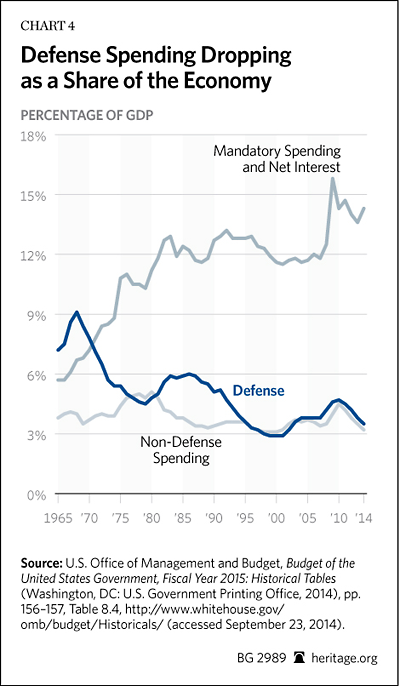
Looking ahead, entitlement programs will continue to be the major drivers of spending and debt. Social Security, Medicare, and Medicaid, including the Medicaid expansion under the Obamacare expansion, are projected to grow faster than the economy and revenues. The CBO projects that Social Security, Medicare, and Medicaid, and interest payments to service the public debt will consume all tax revenues by 2030. This means that the federal government could cease all other operations, including national defense, and would still end up in a fiscal hole within one generation. Entitlement reform is essential to ensure sufficient resources to protect the nation and our allies.
Sequestration was included in the Budget Control Act to push lawmakers to agree to additional deficit-reduction measures, including reductions in entitlement spending. Nevertheless, the “super committee” squandered the opportunity to address the key drivers of spending and debt before sequestration kicked in.
Sequestration targeted the defense discretionary budget for half of the cuts and domestic discretionary and mandatory spending for the other half. Proportionally, defense took a bigger hit and, except for a small reduction in Medicare, entitlements went basically untouched. Since then, lawmakers have raised taxes by more than $3 trillion, and entitlement spending has continued to grow out of control.
To honor the original intent of sequestration, Congress should adopt structural reforms to control the growth of entitlement spending. First, Congress should repeal the Affordable Care Act and replace it with patient-centered, market-based health care.[35] Other reforms could include increases in the retirement age for Social Security and Medicare, slowing the growth in benefits by adopting a more accurate adjustment for inflation, and raising Medicare premiums for wealthier beneficiaries. Bigger, bolder reforms could include increasing progressivity in the Social Security programs with a flat benefit structure or progressive price indexing, consolidate Medicare’s elements and collecting a single higher premium, and phasing in Medicare premium support.[36]
Congressional failure to address spending compromises economic growth and core national priorities, including defense. In the long run, the debt could harm the forces’ capabilities—putting U.S. security at unacceptable risk. The Congressional Budget Office recently stated: “The large amount of debt could also compromise national security by constraining defense spending in times of international crisis or by limiting the country’s ability to prepare for such a crisis.”[37]
Discretionary Savings Inside the Pentagon. Although the DOD does not have sufficient funding, this does not mean that the DOD wisely spends every dollar it has. Congress and the military should implement reforms that would create savings in the military:
-
Reform the military compensation system. (Savings: to be detemined) The military needs to increase its capacity to meet national security requirements, but the needed force size will be unaffordable if the compensation system is not changed. This is not about cutting benefits to the men and women in uniform. The compensation system is archaic and inefficient at incentivizing today’s workforce. Reform initiatives should design a system that can support an all-volunteer force without bankrupting the department.
In the President’s FY 2015 budget proposal, military compensation savings were assumed in the budget topline. The proposed budget of $584 billion does not include the full savings from the DOD’s proposed compensation savings, although it does include those passed in the FY 2015 NDAA.
There are many recommendations on how to reform the military compensation system beyond those proposed by the DOD, including an upcoming report from the Military Compensation and Retirement Modernization Commission due to be released in February 2015. The exact amount of savings will depend on how Congress chooses to reform compensation.
-
Cut the civilian workforce. (Savings: $558 million)[38] Since 2001, civilian employees have grown 14 percent, but active military personnel have been cut 5 percent. The DOD has submitted proposals to reduce the civilian workforce, but at only the same rate as future reductions in military personnel. The DOD should accelerate its plan to reduce the civilian workforce to counter the previous years’ growth and eliminate 13,000 positions in FY 2016, rather than the 7,000 that the DOD has proposed.
-
Cut commissary subsidies. (Savings: $500 million) The DOD has a retail network that includes exchanges run by the services and commissaries operated by the Defense Commissary Agency (DeCA). While the exchanges are self-sustaining operations, commissaries require government appropriations to pay for their workforce. The military has proved it can run a retail system without relying on a government subsidy, and this should be applied to commissaries. Government appropriations to DeCA should be eliminated, and the commissaries should operate on a self-sustaining basis.
-
Close Domestic Dependent Elementary and Secondary Schools (DDESS). (Savings: $533 million) The military currently operates 58 schools in South Carolina, Virginia, Georgia, Alabama, Kentucky, and North Carolina. These schools, all in the South, were necessary because the military had racially integrated, but the local school districts had not. Circumstances have long since changed, eliminating any need for the military to operate schools in the United States where public schooling is readily available. Not only are these schools unnecessary, but they are more expensive per student than public schools. Perhaps more egregious, the military has recently invested money to expand the DDESS infrastructure despite the reduction in defense spending. The military should close these schools and transition the students to public schools, similar to the children of military service members based elsewhere in the U.S.
-
Rely on performance-based logistics (PBL). (Savings: $9,000 million) Performance-based logistics is an approach to managing the sustainment and maintenance work of weapons systems that has proven less expensive and more effective than current methods. A PBL approach focuses on the desired outcome, such as capability requirements, rather than the inputs, such as the number of aircraft repaired. A DOD study has shown broader application of PBL could save up to 10 percent of maintenance and sustainment costs, which average $90 billion each year.[39] The DOD has recognized the benefits of PBL and has recommended using PBL methods in their own acquisition regulations.[40] However, application of PBL is still limited internally.
-
Cut research unrelated to warfighting. (Savings: $140 million) The DOD has an enormous development budget of about $70 billion a year. Most of this funding goes to research and development of weapons systems, but the DOD occasionally funds projects that have little relevance to warfighting. Among them are initiatives to support science, technology, engineering, and math (STEM) education, which the Department of Education should run, not the DOD. Similarly, the National Institutes of Health, not the military, should support research on breast and prostate cancer.
-
Remove the energy mandate. (Savings: to be detemined) The DOD is required to obtain 25 percent of its electricity from renewable sources by 2025. This mandate has no bearing on warfighting capabilities. Any work on renewable energy sources should be based on improving warfighting capabilities, not promoting green initiatives. This mandate has created a bureaucracy focused on its implementation, the exact cost of which is unknown. Congress should repeal the mandate and allow the military to determine when and how renewable energy is a more prudent option for warfighters.
Prioritizing the Budget
In the BBA bill, increased defense spending levels were tied to similar increases in non-defense spending.[41] As the DOD sequestration report noted, “BCA-level funding would have similar impacts for non-defense programs, and any increase in defense discretionary caps should be matched by an equivalent increase in the non-defense caps.”[42]
The equal split of defense and non-defense discretionary spending was originally created by the BCA to impose a greater share of sequestration on defense spending as an incentive for the super committee to produce entitlement reform. Continuing this 50/50 divide is nonsensical. The defense budget needs to be increased because there is justifiable need. These defense requirements do not then justify an increase in non-defense discretionary spending. The 50/50 split is a purely political target. The FY 2016 budget resolution and any follow-on spending legislation should break this link and organize the budget based on federal priorities.
Defense bore 61 percent of the sequestration cuts to discretionary spending compared with the 39 percent that non-defense spending absorbed.[43] There is still room to reduce non-defense spending, which still pays for many ineffective or wasteful programs. In a forthcoming report, The Budget Book: 106 Ways to Reduce the Size and Scope of Government, Heritage itemizes ways to reduce government spending. Leaving aside the 050 account, these savings total more than $50 billion in discretionary spending for FY 2016.[44] These cost savings almost equal the increase in defense spending.
Crafting Responsible Spending Legislation. Responsible spending legislation for FY 2016 would begin to set America back on the path of military and economic strength and security. To do so, Congress should:
- Increase FY 2016 defense spending to $584 billion. Returning to BCA spending levels would further deteriorate an already weakened military and threaten national security as result. There is no innovative silver bullet or internal reform that will provide the U.S. with the best military in the world on the cheap. After years of cuts, the only real solution is to increase the defense budget. Only then can the U.S. begin to repair the damage done to its global posture.
- Reform entitlements. Congress cannot avoid entitlement reform any longer if it wants to control spending. The military and the country simply cannot afford further delays.
- Decouple defense spending from non-defense spending. Threat assessments, the national security strategy and priorities, and the requirements necessary to execute missions justify an increase in defense spending. However, they do not justify more non-defense spending. The two categories should not be linked in determining spending levels, but evaluated separately on their own merits.
- Reduce non-defense discretionary spending. The federal government has been on a spending spree resulting in many wasteful and ineffective domestic programs. Congress should cut non-defense discretionary spending by scaling back or eliminating these programs.
Conclusion
The proposal highlighted in this paper does not fully fund defense. It is simply a first step in rebuilding the military, which has atrophied from imprudent spending cuts, a lack of strategic direction, and neglect by the White House and Congress. Fixing the accumulated damage to the military will take years and a correspondingly growing defense budget. Congress needs to reverse the BCA-level funding for defense, but the country can only afford this if Congress makes serious cuts in non-defense spending and reforms entitlements.
—Diem Nguyen Salmon is Senior Policy Analyst for Defense Budgeting in the Douglas and Sarah Allison Center for Foreign and National Security Policy, of the Kathryn and Shelby Cullom Davis Institute for National Security and Foreign Policy, at The Heritage Foundation. Romina Boccia, the Grover M. Hermann Fellow in Federal Budgetary Affairs in the Thomas A. Roe Institute for Economic Policy Studies, of the Institute for Economic Freedom and Opportunity, contributed to this report.
